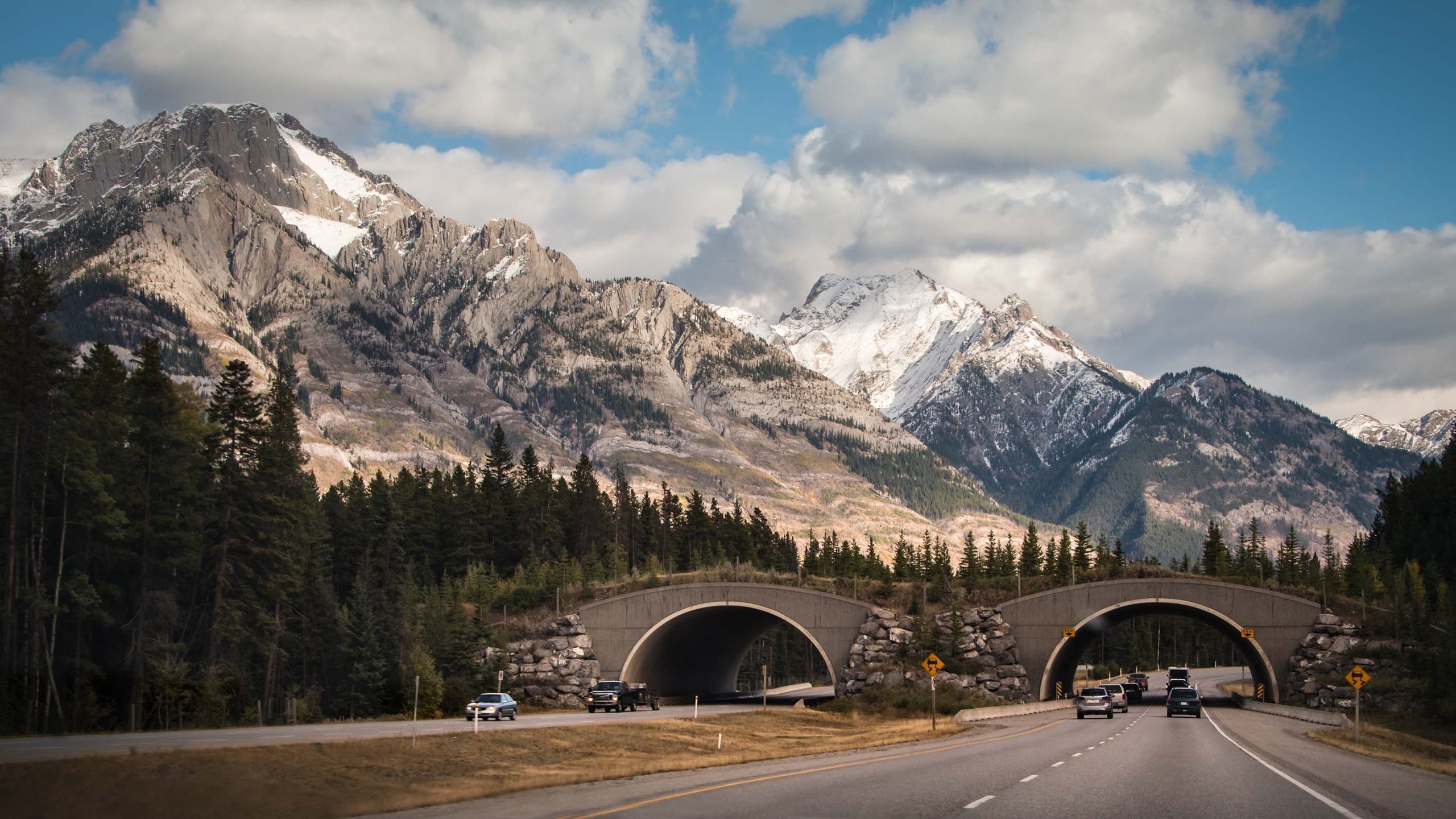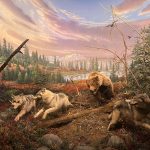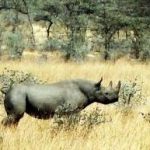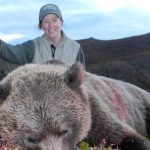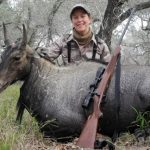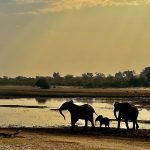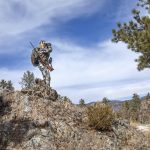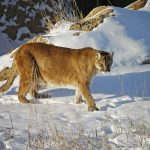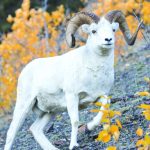Creating corridors that allow wildlife to move is not only good for our game populations, it’s good for people, too.
Photo above: This wildlife crossing, one of dozens in Banff National Park, allows animals to cross the busy Trans-Canada Highway. The tops of these structures are planted with natural vegetation. Data shows they are used regularly by bears, cougars, bighorn sheep, and many other species.
In deer-rich northern Pennsylvania, where I grew up, an apocryphal story used to make the rounds every few years. An adjuster for a large insurance company in Harrisburg, the story went, got very suspicious of all the deer-car collision claims his company was getting from the northern part of the state. Figuring the rubes up north were committing insurance fraud, the adjuster decided to take a road trip to investigate. By the time he arrived in the region, he was frazzled from half a dozen close calls with deer that jumped out into the road in front of him. At that point he turned his car around, headed back to Harrisburg, and stamped all of the deer-related claims “approved.”
Collisions with wildlife were long considered an unavoidable side effect of building roads through wildlife habitat. In the course of our normal “progress,” humans have thrown up all sorts of barriers to wildlife movement. From interstate highways to back roads, to cattle fences, to energy developments and subdivisions, deer, elk, antelope and other animals are constantly faced with dangerous and sometimes impassable obstacles in the course of their daily and seasonal movements. And, as that mythical insurance adjuster found out, as animals inevitably attempt to cross these barriers, it’s not just dangerous or deadly for them, but costly and hazardous for people as well.
Wildlife crossings and migration corridors—the routes that animals travel between their seasonal habitats—have received much-needed attention in recent years. New research has turned a spotlight on the issue, largely because of amazing advances in GPS collars and mapping technology that have allowed scientists to get a much better understanding of where and how far animals move at different times of year in their ongoing quest for food, cover, and mates. These studies also help to identify bottlenecks where their movement is constrained by a highway, fence, or other man-made obstacle.
Roads, of course, are one of the most common impediments to wildlife movement. The federal government estimates at least 1.5 million deer, elk, and moose are killed by vehicles every year. Not only does that mean 1.5 million fewer big-game animals roaming the woods for us to hunt (1.5 million!), but those collisions cost an estimated $10 billion in human deaths, injuries, and auto damage.
Overpasses and underpasses designed especially for wildlife can make a huge difference. The first-ever wildlife “bridges” were constructed in 1975: one was an overpass created for mule deer over I-15 in Utah, and one was an underpass under I-70 in Colorado for elk and deer. These were unusual projects at the time, but not anymore. Thousands of such wildlife crossings have been constructed in recent years, and, as long as they are built in the right spot, their effectiveness is impressive—in Wyoming, one set of crossings near Baggs reduced collisions with deer and antelope by more than 80 percent.
In the past few years, more money has been made available for these projects, partly because they seem to be one of the few things politicians on both sides of the aisle can agree on. Under the Trump administration, Interior Secretary Ryan Zinke signed an order addressing the importance of big-game migrations in the West, and in 2019 the Interior Department directed $2.1 million in grants to state and local partners in several Western states to conserve habitat corridors for elk, mule deer, and pronghorn. More recently, the 2021 Bipartisan Infrastructure Law earmarked $350 million to build wildlife crossings over and under highways.
Wyoming and Colorado are leaders when it comes to helping wildlife find its way. The University of Wyoming’s multi-year Wyoming Migration Initiative has identified a number of very long seasonal migration routes used by pronghorn and mule deer in the western third of the state (dubbed by some “the path of the pronghorn”), and this research has helped wildlife managers understand where they need to work with landowners, tribes, and other partners to help keep those wildlife corridors open so these populations continue to thrive.
In addition to constructing numerous highway crossings for wildlife, Wyoming signed an agreement with the U.S. Department of Agriculture last fall outlining how it plans to work with private landowners to mitigate other barriers to wildlife migration. The agreement provides $16 million to help willing landowners conduct habitat enhancement projects, lease their land for wildlife habitat, and install or remove fencing to benefit wildlife and livestock alike.
The Colorado Department of Transportation (CDOT) has built more than sixty wildlife mitigation structures crossing above or under highways throughout the Centennial State. The most recently completed one allows wildlife to cross US Highway 160 between Durango and Pagosa Springs. According to CDOT, more than 60 percent of all the crashes that were occurring along this stretch of road were wildlife-vehicle collisions. They’re expecting those numbers to drop by 85 percent.
It takes collaborative efforts by numerous agencies, organizations, and individuals to make these projects happen. In the case of the Highway 160 project, wildlife biologists with the Southern Ute Indian Tribe provided the research data that identified seasonal migration patterns and habitat for mule deer and elk in the San Juan Basin area.
“Nineteen years ago, the tribe deployed its first set of GPS radio collars on mule deer. The results of those collars hinted at the importance of this particular spot and stretch of roadway as a migratory crossing point [for big game] on Highway 160,” said Aran Johnson, Southern Ute tribal wildlife biologist.
Colorado and Wyoming are joined by several other western states that have recently enacted laws providing dedicated funding for the study and protection of wildlife corridors. This year, Utah passed a state budget that included $20 million for the construction of wildlife crossings in a state where 5,000 deer and 1,000 elk are killed by vehicles each year. And last year, Californa passed the Safe Roads and Wildlife Protection Act, which takes a comprehensive approach to addressing ecosystem connectivity from a transportation perspective. A project is in the works to create the largest wildlife crossing in the world under Highway 101 in southern California.
While much of the focus on wildlife corridors is happening in the West, eastern states are also taking note. Back in Pennsylvania, which still has one of the highest rates of deer-car collisions in the nation, there are currently only a few wildlife overpasses, mostly in the eastern part of the state. State Representative Mary Jo Daley has been trying for several years to get the Keystone State to conduct a study on the feasibility of constructing more wildlife crossings on the state’s highways. As she reminded one news outlet, “It’s not just wildlife in the West that’s important.”

